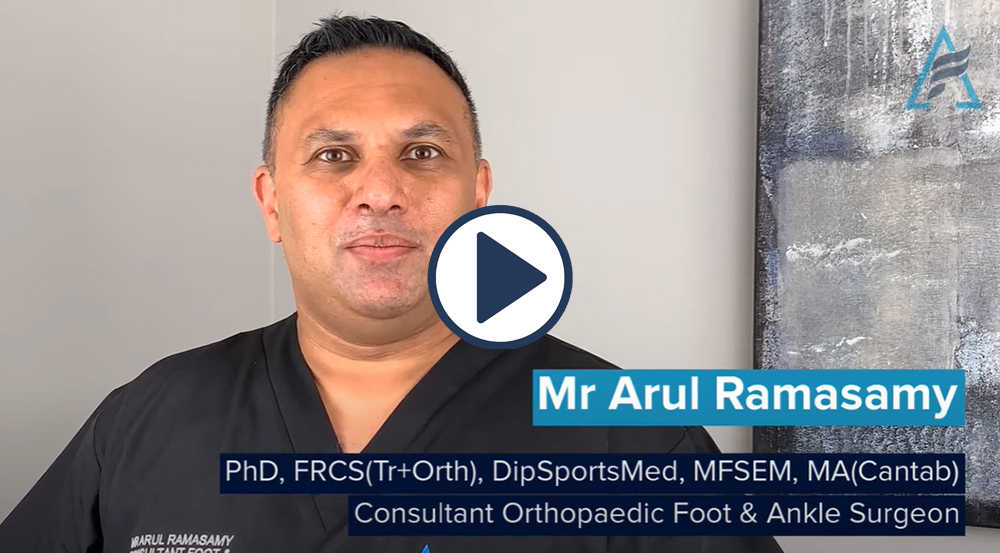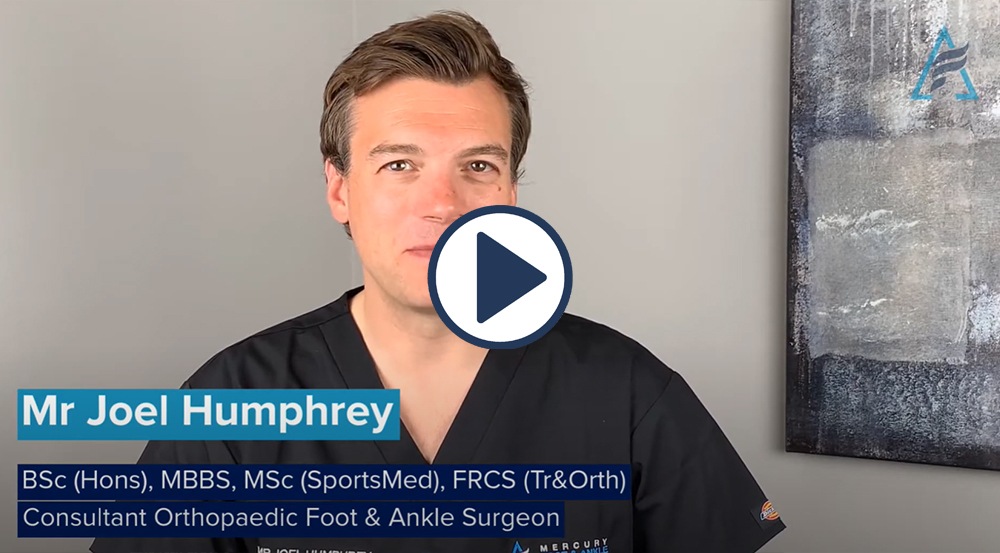Lateral Ligament Reconstruction

What is a lateral ligament reconstruction?
An ankle sprain is when the ligaments on the outside of the ankle are injured when you ‘go over’ on your ankle. The vast majority of ankle sprains get better with simple self-care treatment and physiotherapy. However, a small proportion of patients have on-going ankle instability. The ankle has a tendency to ‘give way’ and you are more prone to repeated ankle sprains. In these cases, an operation can help to provide a stable ankle. The damaged ligaments on the outside of your ankle are reconstructed and it is often known as a Broström procedure.
An operation is only recommended as a last resort, once all non-operative treatment measures for ankle instability have been exhausted and if your symptoms remain significant.
What happens during a lateral ligament reconstruction?
In most cases the operation is performed under general anaesthetic (whilst you are asleep). Alternatively, you can have a spinal or regional anaesthetic, which just numbs the leg.
A surgical cut (5cm) is made on the outside of the ankle. Small plastic anchors with stitches attached are drilled into the bone. The damaged ligaments on the outside of the ankle are then tightened up and anatomically reattached onto the bone. Occasionally, an artificial tape is used to reinforce the reconstruction. Often an ankle arthroscopy is performed in conjunction with a lateral ligament reconstruction.
Once the operation is completed, the wound is closed with stitches, local anaesthetic is given to provide pain relief for the first few hours after surgery and you will be placed in a temporary plaster.
What are the risks of a lateral ligament reconstruction?
The risks of any operation generally relate to the anaesthetic and the surgical procedure.
You will be able to discuss your anaesthetic options and associated risks with the anaesthetist before your surgery. With a general anaesthetic, the risks will vary depending on your general health.
The main surgical risks of a lateral ligament reconstruction are listed below. These will be further explained by us when we see you in the outpatient clinic before surgery.
Swelling– The ankle will swell after surgery in response to the surgery itself and the healing process. It will take more than six months for the swelling to settle.
Failure – There is a small chance that your lateral ligament reconstruction with fail and you may need further surgery. Often this happens following a second injury. You can reduce the risk by following our rehabilitation program to ensure that your ankle is strong and stable before restarting sporting activities.
Nerve injury – With an operation there is always a small risk of injuring or stretching the surrounding nerves, which can lead to numbness. These symptoms mostly resolve in time, but they can persist.
Infection– The wound usually heals within two weeks. In a small number of cases the wounds become infected. The majority are minor infections that can be simply treated with antibiotics. Occasionally, some patients can develop a deeper infection that might require another operation.
Blood clots (leg or lung) – There is small risk of developing a blood clot after ankle surgery. Measures are taken to reduce the chance of this happening but cannot be completely avoided.
Chronic regional pain syndrome – Following foot and ankle surgery a small proportion of patients can develop chronic regional pain syndrome. Your foot becomes indefinitely painful, swollen and sensitive. If you develop this, you may require specialist care from a pain consultant.
What happens after my operation?
When will I go home after surgery?
Most patients can go home on the same day of surgery. You may require an overnight hospital stay if you have other significant medical problems.
Will I be able to walk on it after surgery?
For the first two weeks after surgery you are advised not to put any weight through your operated leg. Before you go home the physiotherapist will make sure you are safe to get around on crutches.
Also, in the first few weeks keep your leg elevated as much as possible to help reduce the swelling and aid wound healing. It is important that your cast remains dry and you may find using a waterproof cover helpful (www.limboproducts.com).
When will you see me after surgery?
You will be seen two weeks after surgery in the outpatient clinic. Your wound will be checked, your stitches removed, and you will be transferred into a surgical boot. You can then start putting weight through your operated leg. The surgical boot should be worn continuously for a further four weeks.
You will be seen again six weeks following surgery to monitor your progress and you can migrate into your own supportive footwear. You will be referred to our specialist physiotherapists who will guide your rehabilitation, focussing on regaining ankle strength and balance. Your final outpatient appointment is usually three months following surgery.
When can I go back to work?
If you have a sedentary job (desk based) and can elevate your foot, you can return to return to work two weeks after surgery. If you have a more physically strenuous job, you may need longer off work.
When can I drive?
You can start driving when you are comfortably walking in your own footwear. If you cannot safely make an emergency stop, your insurance will not cover you in the event of an accident. Start by sitting in the car and trying the pedals, then drive round the block. Drive short distances before long ones. If you are having surgery on your left leg and drive an automatic car, you could consider driving sooner, but only if you are safe to do so.
When can I return to full activity levels?
It varies how quickly people can take up exercise again. You will be guided by our physiotherapists about when you can return to sports. Generally, it takes four months to return to straight line running and longer to sports that involve changing direction.
When can I fly after surgery?
If you are flying after recent surgery you are at an increased risk of developing a blood clot in one of the deep veins in your body, usually the leg (deep vein thrombosis or DVT). Please ask your surgeon for individual guidance on how long to delay flying after your surgery. Also, each airline has its own regulations about flying after surgery and you will need to check with your airline before flying.
Wellbeing Advice
Patients that have a healthy diet, take regular exercise and refrain from smoking are more likely to experience a quicker recovery with a more successful outcome from their surgery.
Taking vitamin C supplements for six weeks before surgery and six weeks after surgery can also be beneficial. You can purchase them from your local pharmacy or supermarket.
If you have any concerns about your general health and well-being (diet, exercise, smoking cessation) you are encouraged to discuss this with your GP, who will be able to provide advice on the options available to you.
We hope this leaflet has answered any questions you might have. If you have any further queries, please feel free to discuss them with any of the medical or nursing staff.
Testimonials

My condition had deteriorated to the point that I was unable to walk for extended periods of time without pain and swelling of the ankle, and I would rarely be able to join in most family activities. The support and guidance provided by Mr Ramasamy were exemplary and enabled me to make a fully informed decision regarding the options available to me. Now, the pain is much more manageable and the stability that the treatment has provided is such that I feel that I regained a significant part of my life and as such my confidence.
I found Mr Ramasamy extremely professional and reassuring. On the day of my procedure I received the most efficient, organised and professional care in my life. Your nurses were the best I have ever experienced. Mr Ramasamy’s team, in theatre made me feel at ease and made the whole procedure more bearable. They go way beyond the extra mile for their patients.
I wanted to share my excellent experiences and compliment Mr Ramasamy and his team. I found him extremely professional and reassured that he understood how much pain I was in. On the day of my procedure, it was the most efficient, organized and professional care I have ever received – from checking into reception to being allocated a bay and taken into theatre – your nurses in the recovery area were the best I have ever received. Mr Ramasay’s team, especially in theatre, made me feel at ease, kept me informed throughout the whole procedure and made the whole procedure more bearable.
Send Us A Message

If you have a question or want to reach out to us directly, use the contact form below and send us a message.








